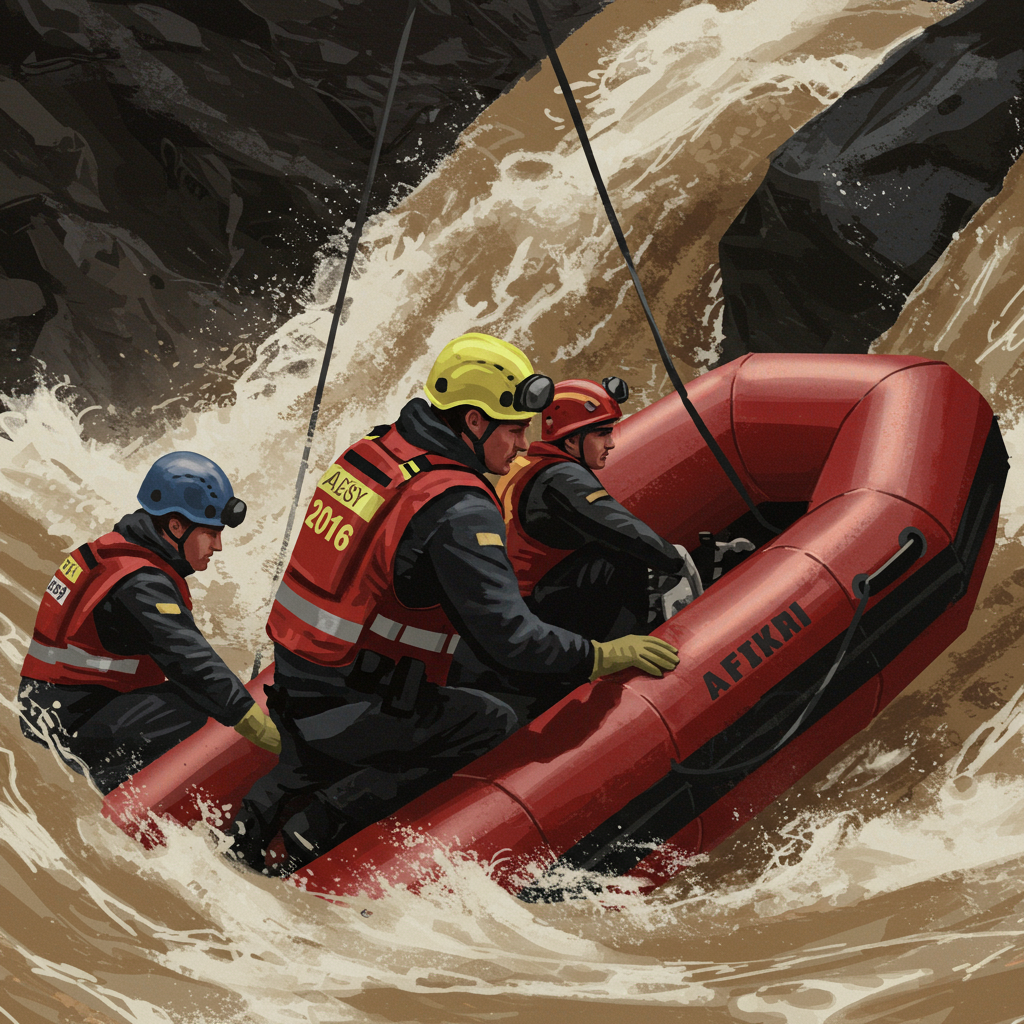A devastating flash <a href="https://news.quantosei.com/2025/07/05/officials-say-nothing-could-have-prepared-them-for-the-guadalupe-river-to-rise-so-fast-meteorologists-disagree/” title=”Deadly Texas Flood: Officials Unprepared? Experts Disagree”>flood tore through the Texas Hill Country along the Guadalupe River corridor, leaving behind a trail of destruction and a rising death toll. At the heart of the tragedy is an urgent search for more than two dozen missing girls from a beloved summer camp. Authorities and volunteers are engaged in a massive, desperate effort to locate those swept away by the sudden, powerful surge of water. This catastrophic event underscores the brutal force of nature and the unique risks faced by communities in Texas’s “flash flood alley.”
Catastrophe Strikes the Guadalupe River
The disaster unfolded with terrifying speed early Friday morning, July 4, 2025, following torrential rainfall. In Kerr County, Texas, the Guadalupe River experienced an almost unprecedented rise. Reports indicate the river swelled by over 20 feet in just two hours near Camp Mystic. Some gauges showed even more dramatic increases, with one near the camp surging 26 feet in a mere 45 minutes. This wasn’t just high water; it was a rapidly moving wall of debris-laden water that overwhelmed everything in its path. The force was so great it damaged or destroyed river gauges themselves. Many residents and visitors, some camping along the river for the Independence Day holiday weekend, were caught completely off guard by the sudden deluge, often in the dark of night. Homes, vehicles, and properties bordering the river were swept away or severely damaged within minutes.
The Rising Human Toll of the Flood
The confirmed death toll from the flood has climbed significantly. According to local officials, at least 32 people have perished. This number tragically includes 14 children. Among those confirmed deceased are individuals with deep ties to the affected communities. The families of several girls who were at Camp Mystic have confirmed their deaths. Additionally, the director of Camp Mystic, Dick Eastland, was confirmed among the fatalities. Jane Ragsdale, a director and counselor at another nearby camp, Heart O’ The Hills, also died. While her camp was not in session for campers, counselors were present. Her passing is deeply mourned by the camp community, highlighting the profound loss felt across the region. The final number of victims remains uncertain as search operations continue.
Desperate Search for the Missing
The immediate focus of the massive response effort is the search for missing individuals. A significant number of those still unaccounted for are associated with Camp Mystic, a private Christian summer camp near Hunt, Texas, which hosted about 750 campers. Authorities confirmed that more than 20 girls from the camp were initially missing. Later updates reported 27 individuals, specifically girls from the camp, were still unaccounted for as of Saturday, July 5. Distraught parents have been desperately awaiting news. Beyond the Camp Mystic group, the total number of missing persons remains unclear due to the number of visitors in the area for the holiday weekend.
Massive Rescue and Recovery Operations
Search and rescue operations have been extensive, continuing through the night and into the following days. More than 1,700 individuals, including hundreds of search and rescue personnel, have been deployed. They are utilizing a range of resources, including over a dozen helicopters, boats, and drones, to scour the affected areas. Efforts are concentrated along the river corridor, targeting summer camps, parks, and low-lying areas. Despite the difficult conditions, including treacherous debris and ongoing rain threats, crews are searching every possible location. So far, over 850 people have been brought to safety, with some rescued from precarious situations like clinging to trees. Officials acknowledge the challenging reality of the search but remain committed to locating every missing person. Governor Greg Abbott instructed responders to continue the search assuming everyone could still be alive. President Donald Trump pledged federal resources to support the state and local efforts, signing a disaster declaration.
Why This Flood Was So Severe
Experts point to a combination of factors that contributed to the extreme and sudden nature of this flood event. The Texas Hill Country is part of what is often called “flash flood alley.” This region’s geography features steep terrain and thin soil layers. When heavy rain falls, the ground cannot absorb it quickly, causing water to rush rapidly downhill and collect in rivers and creeks, leading to swift and dramatic rises.
Meteorological Factors and Unforeseen Intensity
Adding to the geographic predisposition was a specific meteorological setup. Forecasters noted near-record levels of moisture in the atmosphere, combined with the remnants of tropical storm Barry. This convergence created conditions ripe for intense rainfall. While heavy rain was predicted, the sheer volume and speed of the downpour were beyond typical forecasts. Parts of Central Texas received the equivalent of a month’s worth of rain in just a few hours. Hunt, near Kerrville, recorded about 6.5 inches in only three hours, an event described as a “one-in-100-years” rainfall for the area. Some areas saw totals exceeding 10 inches, comparable to four months of average rain falling in just six hours. The combination of intense rain, steep terrain, and saturated ground led directly to the catastrophic flash flooding along the Guadalupe River.
Warning Systems and Preparedness
The sudden onset of the disaster has led to scrutiny regarding warning systems and preparedness. Local officials stated that while forecasts indicated potential heavy rain, the extreme intensity was not anticipated. Kerr County Judge Rob Kelly noted that the county “do not have a warning system” specifically for the Guadalupe River itself and stressed that “no one knew this kind of flood was coming.” Kerrville City Manager Dalton Rice acknowledged that even early-morning city crews were caught off guard by the flood’s rapid escalation.
The Debate Over Alerts
However, private forecasters like AccuWeather have contended that warnings about potential flash flooding were issued hours before the devastation occurred. They argued these warnings should have provided sufficient time for evacuations, particularly for camps located in the high-risk “flash flood alley.” A meteorologist with CBS Austin also defended the National Weather Service, pointing out that a flood watch was issued well in advance, followed by a flash flood warning hours before the river’s significant rise. The difficulty lies in precisely predicting where the most intense downpours will occur within a large watch or warning area until the storm is directly overhead. Survivor accounts paint a grim picture, with residents reporting water rushing in within minutes and some receiving no emergency alerts before the flood arrived.
The Aftermath and Path Forward
The scene along the Guadalupe River on Saturday was one of overwhelming devastation. Witnesses described immense wreckage, including bent vehicles, ripped roofs, and cars mangled in trees. Significant debris clogged riverbanks. State and local authorities have launched a robust response beyond search and rescue, establishing aid stations and signing disaster declarations to expedite access to state and federal resources. Community foundations are collecting donations to support those affected.
Resilience Amidst Devastation
Despite the immense loss and destruction, residents expressed a sense of resilience. Having experienced floods before, some veterans of past disasters, including the severe 1978 flood, stated this event was worse, particularly due to the unprecedented death toll and speed. The region, heavily reliant on river tourism and summer camps, faces a challenging recovery. The threat of further danger lingered, with flash flood warnings and watches continuing into Saturday and forecasts predicting potential additional heavy rain. As search efforts continue and the community begins to grapple with the long road to recovery, the focus remains on finding those still missing and supporting the many who have lost loved ones and livelihoods.
Frequently Asked Questions
How many people died in the Texas flood and how many campers are missing?
As of Saturday, July 5, confirmed reports indicate at least 32 people died in the flash flood along the Guadalupe River in Texas. This tragic total includes 14 children. An additional 27 individuals, specifically girls from Camp Mystic summer camp, were reported as still missing. Authorities have stated that the total number of missing persons beyond this group remains uncertain due to the scale of the disaster and visitors in the area.
What search and rescue efforts are underway for the missing campers?
A large-scale search and rescue operation is actively underway. Over 1,700 personnel, including state and federal teams, are involved. They are using helicopters, boats, and drones to search the Guadalupe River corridor and surrounding areas. The search is particularly focused on Camp Mystic and downstream areas. Rescue teams have already brought over 850 people to safety from the floodwaters, but the search for the missing continues despite challenging conditions and the passage of time since the flood hit.
Why was the flooding along the Guadalupe River in Texas so severe and sudden?
The extreme severity and suddenness of the flood were due to a combination of heavy rainfall, geography, and meteorological factors. Parts of the Texas Hill Country, known as “flash flood alley,” have steep terrain and thin soil that cause rain to run off rapidly instead of soaking in. Torrential rain, including potentially tropical storm remnants and high atmospheric moisture, fell with unusual intensity over a short period – up to 10 inches in hours. This overwhelmed the Guadalupe River basin, causing the river to rise dramatically (over 20 feet in under two hours in some areas) with destructive force, catching many by surprise.
—




